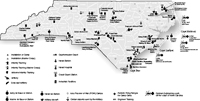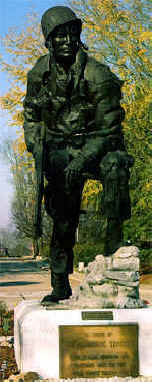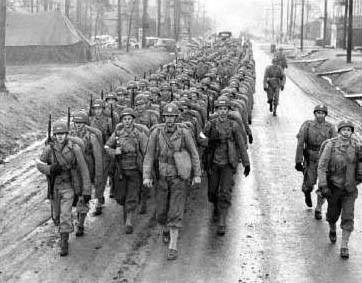Part i: Introduction; Part ii: North Carolina Contributions in Battle and on the Home Front; Part iii: World War II Military Installations in the State; Part iv: Prisoners of War Held in North Carolina
See also: Camp Lejeune; Cherry Point Marine Corps Air Station; Fort Bragg; Liberty Ships; Moore General Hospital; Naval Section Bases; North Carolina, USS; Old Hickory Division; Overseas Replacement Depot; Refugees (World War II); Seymour Johnson Air Force Base; Submarine Attacks
About 2 million fighting men were trained for combat at more than 100 army, navy, marine, and Coast Guard facilities in North Carolina. Several of these bases remained active after the war ended. Fort Bragg, established in 1918, expanded in the early months of the war to become the largest artillery post in the world. Camp Lejeune, a marine base in Jacksonville, housed training facilities for the "devil dogs" canine corps. Cherry Point Marine Air Station provided training grounds for simulated landings and fighter pilots. An Army Air Force Technical Training School at Seymour Johnson Air Force Base opened in Goldsboro in 1941.

Camp Battle, named after Confederate major general Cullen A. Battle, began operating in December 1941 northwest of New Bern as a base for army units protecting bridges over the Neuse and Trent Rivers as well as for the 111th Infantry, a Pennsylvania National Guard unit stationed there in 1942. The Asheville Naval Convalescent Hospital, where 6,663 sailors and patients from Holland, Great Britain, France, and China were treated, opened on 23 May 1943 in the 225-room Appalachian Hall in Kenilworth Park. Capt. William A. Angwin was its commanding officer until the convalescent home closed on 10 Apr. 1946. Camp Butner, a U.S. Army infantry camp named for Maj. Gen. Henry Wolfe Butner, a native of Surry County and commander of the First Artillery Brigade in World War I, began operations on 4 Aug. 1942. Located on approximately 40,000 acres in Granville, Person, and Durham Counties, this base conducted training exercises for an estimated 30,000 soldiers.
Camp Davis, the first antiaircraft base in the country and an army coastal artillery training center located on 46,683 acres in Onslow and Pender Counties, was built between December 1940 and April 1941. At its peak in 1943, more than 100,000 soldiers and civil service workers were stationed there. The camp was named in honor of Maj. Gen. Richmond Pearson Davis, a native of Statesville, commander of the 151st Field Artillery Brigade in France during World War I and later chief of artillery for the Ninth Corps. Camp Mackall, dedicated on 1 May 1943 in memory of 22-year-old Pvt. John T. Mackall, the first World War II paratrooper to lose his life in action, was a military training installation adjacent to Fort Bragg in Richmond and Scotland Counties. A portion of the camp survived after the war and was used as a wilderness training area by soldiers of the Special Forces (Green Berets). Camp Mackall was the center of training for glider pilots and soldiers and the site of early experiments in glider techniques; thousands of fledgling army paratroopers and glidermen prepared for battle there. Late in the war it was also the home of the 555th Parachute Infantry Battalion, the only combat unit of paratroopers composed of black soldiers.

Camp Sutton, on the outskirts of Monroe, was named for the city's first war casualty, Frank Howie Sutton, a Royal Canadian Air Force volunteer who died on 7 Dec. 1941 during fighting near Tobruk, North Africa. In March 1942 Camp Sutton was established as an expanded temporary military facility for about 18,000 overflow troops from Fort Bragg. When its training center was shut down in October 1944, it became a prisoner of war (POW) camp. After it closed in March 1946, the camp's 2,000 acres were annexed to the city of Monroe, doubling its size and providing a site for later industrial development.
Bluethenthal Field, New Hanover County's second airfield, was dedicated on 30 May 1928 in memory of Arthur Bluethenthal, the first Wilmingtonian killed in World War I. The field had served as a civilian airport until the day after Pearl Harbor, when the Army Air Corps moved in-two squadrons of army P-40 pursuit planes had already been stationed at the airfield to defend the area from enemy bombers-and banned civilian flying. The "Wilmington Army Airport" then swallowed up neighboring farms and houses, increasing its size to over 1,200 acres. First employed as a base for bombers on coastal patrol, it later was used for pilot training on P-47 fighter aircraft. During World War II the federal government invested $11 million in the airfield. After the war, the airport was returned to the county and came to be called the New Hanover County Airport in the 1950s.
The Elizabeth City Coast Guard Air Station opened on 15 Aug. 1940 with 10 aircraft but ended the war with 55. Placed under navy command in November 1941, the station patrolled the Atlantic from the Virginia capes to Cape Lookout. Its aircraft escorted convoys and flew antisubmarine patrols, although they were not sufficiently armed to sink U-boats until late 1943, when the worst of the submarine devastation was already over. The pilots' most important function, therefore, was rescuing survivors of sunken ships. From December 1941 to July 1944 the air station recovered or assisted 186 persons. In late 1944 the station adjusted its mission to air-to-sea rescue. During the war the station shared the airfield with a coast artillery air squadron and a naval blimp unit, and the Coast Guard operated various schools there.

Laurinburg-Maxton Army Air Base, activated on 28 Aug. 1942, covered more than 5,000 acres in Scotland County. Its initial purpose was to offer both aircraft transport and training for infantry and airborne troops. The federal government deactivated the base shortly after the war and eventually deeded the property to the towns of Laurinburg and Maxton; by the mid-1950s the former military base had become an industrial park.
What became the Weeksville Naval Air Station was constructed in 1942 on 640 acres in Pasquotank County approximately four miles south of Elizabeth City. It served as a base for blimps to patrol the coast and escort coastal shipping. In 1947 the station began its second era with lighter-than-air ships designed with new technology. Two blimp squadrons and an antisubmarine helicopter squadron were based at Weeksville until 31 May 1957, when the blimp squadrons were decommissioned. The 1,000-foot-long hanger, known as Airdock 2, the largest wooden building in the world, was destroyed by fire on 3 Aug. 1995.
The Charlotte Quartermaster Depot, part of the Quartermaster Corps of the U.S. Army, opened on 15 May 1941 to supply bases in the Carolinas with items ranging from toothbrushes and bar soap to M1 Garand rifles and gun oil. Eventually the 72-acre site featured 1.2 million square feet of warehouse space and 400,000 square feet of open ground. In early 1942 the depot employed 80 army personnel and more than 2,500 civilians. By the mid-1940s it was one of the most significant depots in the southeastern United States. After the war, it was taken over by an American Graves Registration unit, which worked to deliver the identified remains of 5,170 deceased soldiers to their families in North Carolina, South Carolina, Virginia, Tennessee, and Georgia. The depot was deactivated in January 1949.
North Carolina's other important wartime bases were the Lake Lure Army Air Force Rest and Redistribution Center, Knollwood Field at Winston-Salem, the Elizabeth City Marine Air Corps Station, Morris Field at Charlotte, the Pineville Naval Station, Pope Field in Fayetteville, the Overseas Replacement Depot in Greensboro, and the Raleigh-Durham Army Air Field.